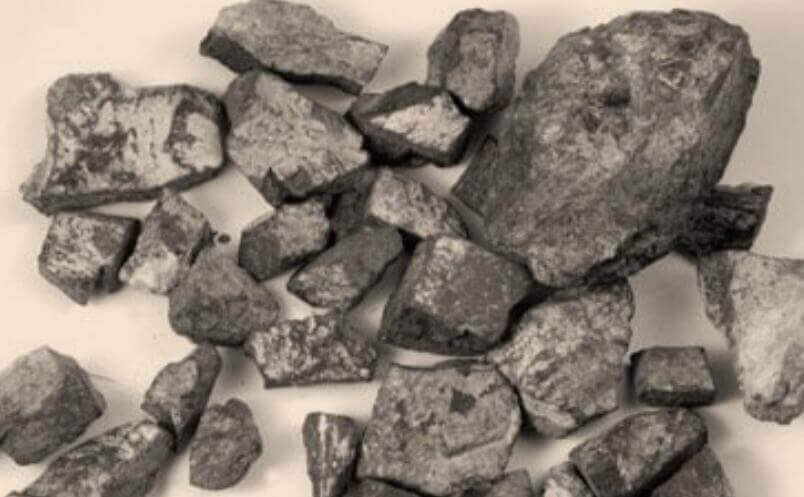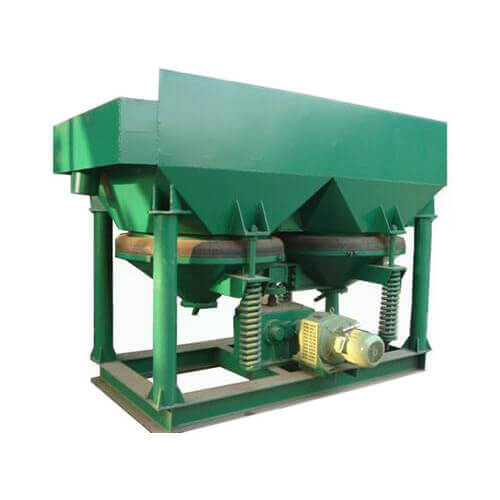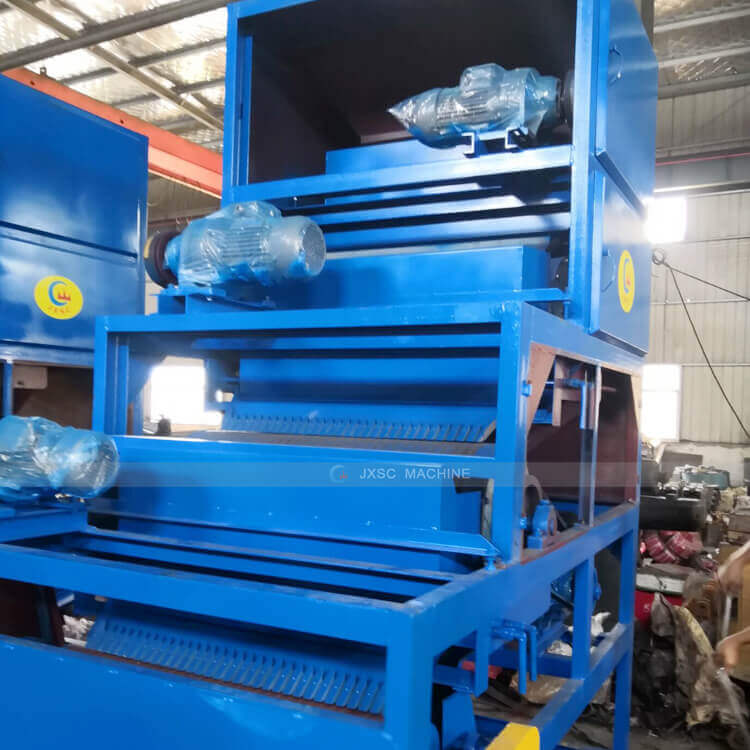The tantalum and niobium ore beneficiation and roughing generally adopt the gravity separation method, and the selection adopts the gravity separation, flotation, electromagnetic separation, or the combined process of beneficiation and smelting. To deal with the ore with a high content of powder or primary mud, the washing operation is essential. High-efficiency grinding and grading equipment to reduce the sliming of tantalum and niobium minerals.
Mineral Technology Characteristics of Tantalum-niobium Ore
The general chemical formula of niobite-tantalite is AB2O6, and the two are referred to as niobium-tantalite. A is iron and manganese, and B is niobium and tantalum. The magnetic susceptibility of niobite-tantalite is (22.1~37.2)×10-6. The dielectric constant of niobite is 10 to 12, and that of tantalite is 7 to 8. The density of minerals is 5.15 to 8.20 (increases with the increase of tantalum content).
Mineral Processing Technology of Tantalum and Niobium Ore
The tantalum-niobium ore beneficiation generally adopts gravity separation to discard most of the gangue minerals to obtain low-grade mixed rough concentrate. Various beneficiation methods such as gravity separation, flotation, electromagnetic separation, or combined process of beneficiation and metallurgy are used for selection, so as to achieve the separation of various useful minerals.
Foreign Tantalum and Niobium Beneficiation
To deal with ore with high content of fine ore or primary mud, washing operation is essential. The weathered pegmatite alluvial clay roughing plant in Greenbush Mine, Australia, has two washing systems. The raw ore is washed twice with a cylindrical screen with a diameter of 1.5m and an aperture of 10mm. The clay balls enter the self-grinding machine to grind about 4mm and then sieve with a cylindrical sieve with an aperture of 10mm. The water consumption for ore washing is 5m3/t, and the processing capacity of the cylindrical screen reaches 350 tons/hour. Foreign tantalum and niobium concentrators attach great importance to the use of high-efficiency grinding and classification equipment to reduce the sliming of tantalum and niobium minerals. The primary pegmatite roughing plant of the Greenbush Mine achieved good results with the closed circuit of the peripheral discharge rod mill and the vibrating screen. The Bernick Lake tantalum mine in Canada has been continuously improved, and the grinding process currently used is very distinctive. The mine uses a Ф2.4m×3.6m Massey-type grid ball mill AC horizontal vibrating screen (linear screen) closed circuit, the sieving particle size is 2.5mm, and the sieve is classified by 0.2mm with a Derek sieve, -2.5+0.2mm particles The grades are sorted by a spiral concentrator, and the tailings are dewatered by an arc screen and then returned to be ground again. The ball mill has two kinds of products to form a cycle, that is, one mill is used to realize two-stage closed-circuit grinding. The cyclic load rate of this grinding circuit is usually about 180% after adjustment, and it is easy to cause over-grinding if the cyclic load is small. The roughing of tantalum-niobium iron ore in foreign countries is still dominated by gravity separation, and high-efficiency gravity separation equipment is used, and the process is simple. For example, Greenbush Mine directly uses a jig for roughing of -10mm raw ore. The gravity separation-flotation-gravity separation process formed in the 1980s at the Bernick Lake tantalum mine in Canada is becoming more and more perfect. The process is still dominated by gravity separation, and flotation is only used to treat fine mud. The gravity separation equipment adopts GEC spiral concentrator, 3-layer suspended Dyster shaker, Holman mud shaker, and cross-flow belt concentrator. In the former Soviet Union, flotation was used to separate tantalite, fine spar, and topaz in the gravity concentrate. The collector was hydroxamic acid, and the regulator was oxalic acid. When the content of Ta2O5 is 2.52%, the concentrate grade is 27% and the recovery rate is 90%.
Tantalum and Niobium Beneficiation at Home(In China)
1. Roughing of tantalum and niobium ore
Tantalum-niobium ore grades in China are generally very low, and their minerals are brittle and dense. In order to ensure the grinding particle size and avoid over-grinding, the stage grinding stage separation process is generally adopted. Jiangxi Yichun Tantalum and Niobium Concentrator adopt a lateral arc screen instead of a linear vibrating screen for screening. The results of the on-site exploration test show that the fineness of the upper screen can be reduced by 14.70%, the thickness of the under-screen can be reduced by 4.3%, and the screening efficiency can be improved by 17.72%. The successful test of the equipment provides a new way for the transformation of the first stage of grinding and screening on-site. Nanping, Fujian is a large-scale granite pegmatite deposit. In 1998, Guangzhou Nonferrous Metals Research Institute conducted a beneficiation test study on the ore to provide a design basis for the construction of the plant. Grinding and stage sorting process. The first section uses a rod mill and forms a closed circuit with a sieve to reduce over-grinding. The second-stage grinding adopts a ball mill and forms a closed circuit with a high-frequency vibrating fine screen. In addition to strictly controlling the particle size, it can also increase the processing capacity and improve the grinding efficiency. The ore roughing adopts a single gravity separation process. The gravity separation equipment includes GL spiral concentrator, spiral chute, and shaking table. The selected raw ore contains (TaNb)2O5 0.0499%, Sn 0.0598%, the rough concentrate obtained after roughing is 0.248%, contains (TaNb)2O5 14.94% (including Ta2O5 10.79%), and the recovery rate of the raw ore is 0.248%. It is 74.30% (Ta2O5 recovery rate is 74.96%); with Sn 15.71%, the recovery rate of raw ore is 65.11%.
2. Tantalum and niobium ore concentration
The rough concentrate obtained by the roughing process is generally mixed rough concentrate, which needs to be further selected to separate out a variety of useful minerals. For example, Fujian Nanping tantalum and niobium first use 6% hydrochloric acid solution to clean the mineral surface, then use weak magnetic separation to remove strong magnetic minerals and iron filings, dry and sieve into three grades of +0.2, +0.1, and -0.1mm, respectively. The tantalum and niobium concentrate was obtained by a dry high-intensity magnetic separator through one roughing and one sweeping. 69.92% (Ta2O5 recovery rate 69.071%), select operation recovery rate 94.11%.
3. Flotation of fine-grained tantalum-niobium ore
The No. 69 ore body in the Dajishan tungsten deposit in Jiangxi Province is a large-scale tantalum-niobium-tungsten-tungsten granite ore body. The tantalum-niobium-iron minerals in this ore are embedded with very fine particle sizes, most of which are in the range of 40-74 μm. According to the selection method, the recovery rate of ore dressing is low, and the recovery rate of tantalum is only 25% to 33%. Guangzhou Nonferrous Metal Research Institute adopts the combined heavy-flotation process to recover tantalum and niobium minerals. When the flotation feed Ta2O5 is 0.0145%, the flotation concentrate rate is 0.7%, and the concentrate contains Ta2O5 1.8%. The recovery rate of tantalum is 87%. The ore enrichment ratio is more than 100 times. Then re-selection enrichment, hydrometallurgical separation of tantalum and tungsten. The recovery rate of tantalum dressing and smelting reaches 44%. The ore properties of the Bayan Obo Mine in Baotou are very complex, especially the niobium minerals are famous for their lean, fine, and miscellaneous refractory separation. NO3)2 is the activator, D-1 is the inhibitor of calcium minerals, and the combined collector is mainly hydroxamic acid. Niobium flotation is carried out in the medium of pH 6, and the niobium coarse concentrate enriched by flotation is desulfurized. Afterward, the weak magnetic-shaking table process is used for selection to obtain rich niobium iron ore concentrate and iron ore concentrate. The rich niobium iron concentrate 1 contains 1.66% Nb2O5, concentrate 2 contains 0.59% Nb2O5, and the total recovery rate of niobium is 35.58%. After studying the rare earth flotation tailings in Bayan Obo Mine, Chen Quanyuan et al. proposed that after the rare earth flotation tailings are concentrated and deslimed, oxide paraffin soap, water glass anti-flotation fluorite, and residual rare earth minerals are added, and the products in the tank are concentrated. After that, add ammonium fluorosilicate and paraffin soap to flota iron minerals to obtain iron concentrate, and add sulfuric acid, carboxymethyl cellulose, salicylic hydroxamic acid, C5-9 hydroxamic acid, and oxalic acid to the iron tailings. The niobium flotation concentrate containing 1.67% of Nb2O5 and the recovery rate of 40.14% was obtained by roughing and three-time beneficiation. The concentrate is then subjected to strong magnetization to separate iron and niobium to obtain niobium concentrate as a non-magnetic product and niobium secondary concentrate as a magnetic product.
LATEST PRODUCTS
Twin Screw Feeder
【Feeding Capacity】 10-160 t/h【Power】 2.2-…
Tubular Screw Conveyor
【Capacity】6-50 m3/h【Procesible Material】 …
Heavy Plate Feeder
Capacity: 100-240 m3/h Power: 15-45 kW Speed: 0…












